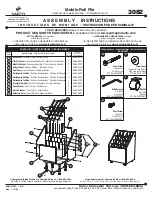
Velp Scientifica
– UDK139 Operating Manual
10004762/B5
64
Selenium dioxide (SeO
2
) and 100 g of anhydrous Sodium sulphate (Na
2
SO
4
) are
dissolved by 500 ml of ammonia free water and then 500 ml of concentrated
sulphuric acid are added.
Ammonia free distilled water for dilutions
Add 0.1 ml of concentrated sulphuric acid (H
2
SO
4
) to one liter of distilled water and
distill again.
It is also possible to use deionized water with very low conductivity, obtained by a
mixed bed of strong anionic and cationic resins, and tested for the absence of
ammonia and of Nitrogen containing organic matter (biofouling).
A complete equipment for the production of ammonia free distilled water is shown in
the following scheme:
1)
Water supply
6)
Fritted glass
2)
Water still
7)
Ari
3)
distilled water collecting vessel
8)
Liquid seal
4)
Glass fiber
9)
Ammonia-free distilled water collecting
5)
Ion exchange column. Strongly acidic
vessel
cation exchange resing mixed with a strongly
basic anion exchange resin
Sample to be analyzed
Liquid, semisolid or solid samples can be submitted to analysis. If a liquid is
measured by volume the result will be referred to volume and not to weight if the
density is different from 1.
When the result is to be referred to dry weight, solid or semisolid samples containing
water must be desiccated to constant weight. Grinding of samples is aimed to obtain
an easier digestion but is mostly aimed to homogenize the matter in order to obtain
significant results. Weighing accuracy is 0.1 mg.
To allow a quantitative transfer of a solid or semisolid sample into the digestion tube,
it is recommended to use weighing boxes made with Nitrogen free parchment paper
(Code CM0486000). These boxes will be introduced with the sample into the tubes
and digested without modifying the result. Sample dimensions are related to Nitrogen
content and must give at least 10-15 mg of ammonia Nitrogen. If a sample is
evaluated as poorly homogeneous, amounts larger than normal (e.g. 3-4 g) are to be
analyzed.
251
















































